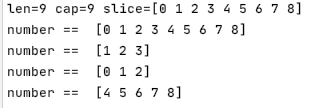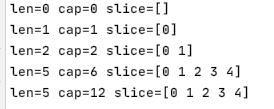Go language -- detailed explanation of slice
Blog description
The information involved in this article comes from Internet collation and personal summary, which means personal learning and experience summary. If there is any infringement, please contact me to delete, thank you!
Explain
Go language slicing is an abstraction of arrays.
The length of go array cannot be changed, and such a set is not suitable in a specific scene. Go provides a flexible and powerful built-in type slice ("dynamic array"), which is not fixed compared with array, and can append elements. When appending, it may increase the capacity of slice.
Defining slices
Note: the length of the slice does not need to be specified
1. Declare an array of unspecified size to define slices
var identifier []type //for example var slice []int
2. Use the make() function to create slices
var slice1 []type = make([]type, len) //It can also be abbreviated as slice1 := make([]type, len) //for example slice := make([]type, len)
Slices are indexable
len() and cap() functions
The length can be obtained by the len() method.
Slicing provides a way to calculate capacity cap() can measure the maximum length of slicing
package main import "fmt" func main(){ var number = make([]int,3,5) fmt.Printf("len=%d cap=%d slice=%v\n",len(number),cap(number),number) } //len=3 cap=5 slice=[0 0 0]
Nil slice
A slice is nil by default and 0 in length before it is initialized
package main import "fmt" func main(){ var number []int fmt.Printf("len=%d cap=%d slice=%v\n",len(number),cap(number),number) } //len=0 cap=0 slice=[]
Slicing
You can set the lower bound and upper bound to cut slices [lower bound: upper bound]
package main import "fmt" func main() { //Create slice number := []int{0, 1, 2, 3, 4, 5, 6, 7, 8} printSlice(number) //Print original slice fmt.Println("number == ", number) //Print sub slice from index 1 to index 4 fmt.Println("number == ", number[1:4]) //Print sub slice default lower limit fmt.Println("number == ", number[:3]) //Default upper limit of print subsegment fmt.Println("number == ", number[4:]) } func printSlice(x []int) { fmt.Printf("len=%d cap=%d slice=%v\n", len(x), cap(x), x) }
Result

Increase slice capacity
Principle: create a new and larger slice and copy the contents of the original slice
append() and copy() functions
package main import ( "fmt" ) func main() { //Create slice var number []int printSlice(number) //Allow appending empty slices number = append(number,0) printSlice(number) //Add an element to the slice number = append(number,1) printSlice(number) //Add multiple elements at the same time number = append(number,2,3,4) printSlice(number) //New slices created are twice the capacity of previous slices number1 := make([]int,len(number),(cap(number))*2) //Copy number to number1 copy(number1,number) printSlice(number1) } func printSlice(x []int) { fmt.Printf("len=%d cap=%d slice=%v\n", len(x), cap(x), x) }

Thank
Rookie tutorial
Omnipotent network
And the industrious self